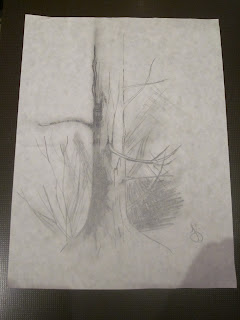
Drawing is an affordable activity that can be done almost anywhere. Drawing is a great outlet for people of all ages and a wonderful means for expressing oneself. Improvements in drawing skills can be seen with practice and instruction, so this activity can be incredibly fun and rewarding.
Pick a drawing, photo, or other piece of artwork which consists of several different lines and shading (for example, our class was given the pencil drawn tree). The tree was used to introduce the class to different pencil types (6H-6B) and how each of these pencil types can be used to produce a different type of line, and create and enhance the technique of shading.
Materials:
Drawing (or other piece of artwork for class the replicate), multiple pieces of paper for each student, samples of each pencil (6H-6B)
Process:
1) Hand out a copy of the "tree" to each student and have them take note of the different lines (thin, thick, dark, light), the directions of the lines, and the shading
2) Introduce the system for classifying pencils and what the classification system means (HB is in the middle of the spectrum, H is "hard", B is "soft")
3) Hand out a sample of various pencils to each group and have the students experiment with the different numbered and lettered pencils
4) Ask the students to draw a picture corresponding to the one given (for example, draw roots to go with the picture of the tree)
5) Instruct the students to replicate (BUT NOT TRACE OR COPY) the given piece of art with as much detail as possible
*ask them to specifically pay attention to lines (thickness, direction etc.) and shading*
6) Allow the students several minutes to perform this activity
7) When their pictures are complete, ask them to combine their "roots" and their "trees"
8) The class stands in a circle where each student has the opportunity to present what they have done
Technical Terms and Definitions
Pencil Classification System: Graded on the European system, where "H" stands for "hardness" and "B" for "blackness" or "softness". Runs from 9H to 9B, with HB (the typical pencil sold) in the middle. Number designates how many letters are in the sequence. May be useful to have students replicate a chart as seen below:
Shading: A process of depicting levels of darkness by creating dense, or less dense, areas of colour. There are various ways to accomplish this (use of different pencils, or cross hatching).
Observe a Child Drawing
1) Emily chose to draw "anything". Instead of telling us what she was going to draw she asked us to guess. She chose to use an HB pencil and no colours in her drawing. Her drawing seemed very well practiced and she was very particular (for example; erased a flower in the corner to put in a bush, flowers were all evenly spaced across the bottom of the page). Emily drew a sun in the top corner of the page, which I have noticed is very typical for children to do, and her clouds all had three bumps on the bottom and three on the top. She defined her final picture as "their garden" and did not speak much while engaged in her artwork, but was otherwise and very talkative and social young girl.
2) For the self portrait drawing, Emily chose to use a pencil and paper once again. She began by asking her Dad if she could get a mirror to look in while she drew. Emily rotated the paper as she drew a large round shapes (a large oval shape for her face). She seems to be a very particular artist and took adequate time to draw and space each individual eye lash. She would glance in the mirror quite often, and smiled a big smile before adding that feature to her portrait. Emily drew a very interesting depiction of a nose (very good and close to being "adult like").




